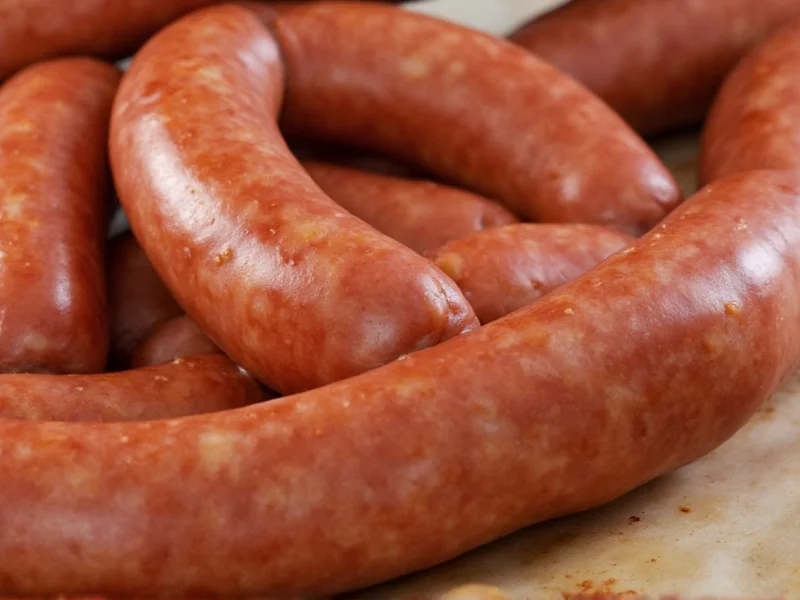The safe internal temperature for most sausages is 160°F (71°C), while poultry sausages require 165°F (74°C) to ensure food safety. This critical temperature kills harmful bacteria like Salmonella and E. coli that may be present in raw meat. Always verify with a reliable meat thermometer inserted into the thickest part of the sausage, avoiding contact with the cooking surface.
Understanding the proper internal temperature for sausage isn't just about achieving perfect texture—it's a crucial food safety requirement. Many home cooks rely on visual cues like color or firmness, but these methods can't reliably indicate whether potentially dangerous bacteria have been eliminated. The USDA Food Safety and Inspection Service has established specific temperature guidelines that apply to all sausages, whether you're cooking store-bought varieties or homemade creations.
USDA Guidelines for Sausage Temperature Safety
The United States Department of Agriculture provides clear temperature standards that all sausage producers and consumers should follow. These guidelines represent the minimum internal temperatures required to destroy pathogens that cause foodborne illness:
| Sausage Type | Minimum Internal Temperature | Equivalent in Celsius |
|---|---|---|
| Beef, Pork, Lamb Sausage | 160°F | 71°C |
| Chicken, Turkey Sausage | 165°F | 74°C |
| Pre-cooked Sausages (heating) | 140°F | 60°C |
These temperatures aren't arbitrary—they're scientifically determined thresholds where harmful bacteria like Salmonella, E. coli, and Listeria are effectively destroyed. For pork sausage specifically, the 160°F standard ensures trichinella parasites are eliminated, though modern farming practices have made trichinosis extremely rare in commercial pork.
Why Visual Cues Alone Aren't Enough
Many home cooks mistakenly believe that sausage is done when it's browned on the outside or when the juices run clear. However, color changes in meat occur at lower temperatures than those required for food safety. Sausage can appear fully cooked at temperatures as low as 140°F while still harboring dangerous pathogens.
The pink color sometimes remaining in properly cooked sausage often comes from curing agents like sodium nitrite, not undercooking. This is particularly common in smoked sausages and bratwursts. Relying on color alone could lead to foodborne illness, especially with ground meats where bacteria can be distributed throughout the product.
Proper Technique for Measuring Sausage Temperature
Accurate temperature measurement requires proper technique:
- Select the right thermometer: Use a digital instant-read thermometer for best results—not the dial thermometers that come with many ovens
- Insert correctly: Place the probe into the thickest part of the sausage, avoiding contact with the cooking surface or bone
- Check multiple pieces: When cooking multiple sausages, check several as they may cook at different rates
- Wait for stabilization: Hold the thermometer in place until the reading stops changing (about 15 seconds)
- Clean between uses: Sanitize your thermometer between measurements when checking different types of meat
For sausages on the grill or in a pan, check temperature toward the end of the estimated cooking time. Remove sausages from heat when they reach 155-158°F for pork/beef varieties or 160°F for poultry, as the temperature will continue rising 3-5 degrees during resting.
Special Considerations for Different Sausage Types
Not all sausages follow the same temperature rules. Understanding these distinctions ensures both safety and optimal quality:
- Raw vs. Pre-cooked Sausages: Raw sausages must reach the full 160°F (165°F for poultry), while pre-cooked varieties only need to be reheated to 140°F
- Homemade Sausages: When making sausage from scratch, follow the same temperature guidelines but be extra careful about cross-contamination during preparation
- Smoked Sausages: Many smoked sausages are fully cooked during processing, but always verify packaging instructions as some require final cooking
- Fresh Bratwurst: Despite popular belief, bratwurst isn't safe at 150°F—it must reach 160°F for safety
Food Safety Risks of Undercooked Sausage
Serving sausage below the recommended internal temperature creates significant health risks. Ground meats are particularly vulnerable because the grinding process distributes surface bacteria throughout the product. Potential consequences include:
- Salmonella: Causes fever, diarrhea, and abdominal cramps; particularly dangerous for children and elderly
- E. coli: Can lead to severe stomach cramps, diarrhea (often bloody), and vomiting
- Listeria: Especially concerning for pregnant women, causing miscarriage or stillbirth
- Trichinosis: Though rare in commercial pork, still a risk with undercooked wild game sausages
The Centers for Disease Control estimates that foodborne illnesses affect 1 in 6 Americans annually, with ground meats being common culprits. Proper temperature verification is your most reliable defense against these preventable illnesses.
Temperature Verification Tools and Alternatives
While a quality meat thermometer is essential, understanding your tools improves accuracy:
- Digital Instant-Read Thermometers: Most accurate option; provides readings in 3-10 seconds
- Leave-in Probe Thermometers: Useful for monitoring temperature during extended cooking
- Thermometer Calibration: Test accuracy by placing in ice water (should read 32°F/0°C) or boiling water (212°F/100°C at sea level)
- Thermometer Placement Errors: Avoid touching bone, fat pockets, or the cooking surface for accurate readings
There are no reliable alternatives to a proper meat thermometer for verifying sausage doneness. Time-based cooking guidelines vary too much based on sausage size, cooking method, and equipment. The only way to guarantee safety is through direct temperature measurement.
Resting Time and Temperature Carryover
After removing sausages from heat, the internal temperature continues to rise due to residual heat—a phenomenon called “temperature carryover.” Proper resting allows this process to complete while redistributing juices:
- Rest sausages for 3-5 minutes before serving
- During this time, temperature typically rises 3-5°F
- Remove from heat when 3-5°F below target temperature
- Cover loosely with foil to retain heat without steaming the casing
This resting period ensures the sausage reaches the safe minimum temperature while maintaining optimal texture and juiciness. Skipping this step might result in sausages that appear properly cooked but haven't reached the necessary internal temperature throughout.











 浙公网安备
33010002000092号
浙公网安备
33010002000092号 浙B2-20120091-4
浙B2-20120091-4